Creating a Robust Operation Plan: Strategies and Implementation
VerifiedAdded on 2023/06/15
|6
|1155
|186
Report
AI Summary
This report provides a detailed overview of an operation plan, emphasizing its role in achieving strategic goals through efficient processes and regular monitoring. It covers essential models and methods for operational planning, highlighting the importance of aligning with the organization's vision and mission. The report discusses the budgeting process, differentiating between operational and capital budgeting, and explains how to estimate costs and revenues for daily business activities. It also explores different approaches to developing key performance indicators (KPIs), focusing on outcome and process metrics, and emphasizes the need for KPIs to be meaningful, measurable, and manageable. Furthermore, the report addresses the importance of legal compliance and adherence to organizational policies, practices, and procedures in developing a robust operation plan. Desklib offers more resources for students.
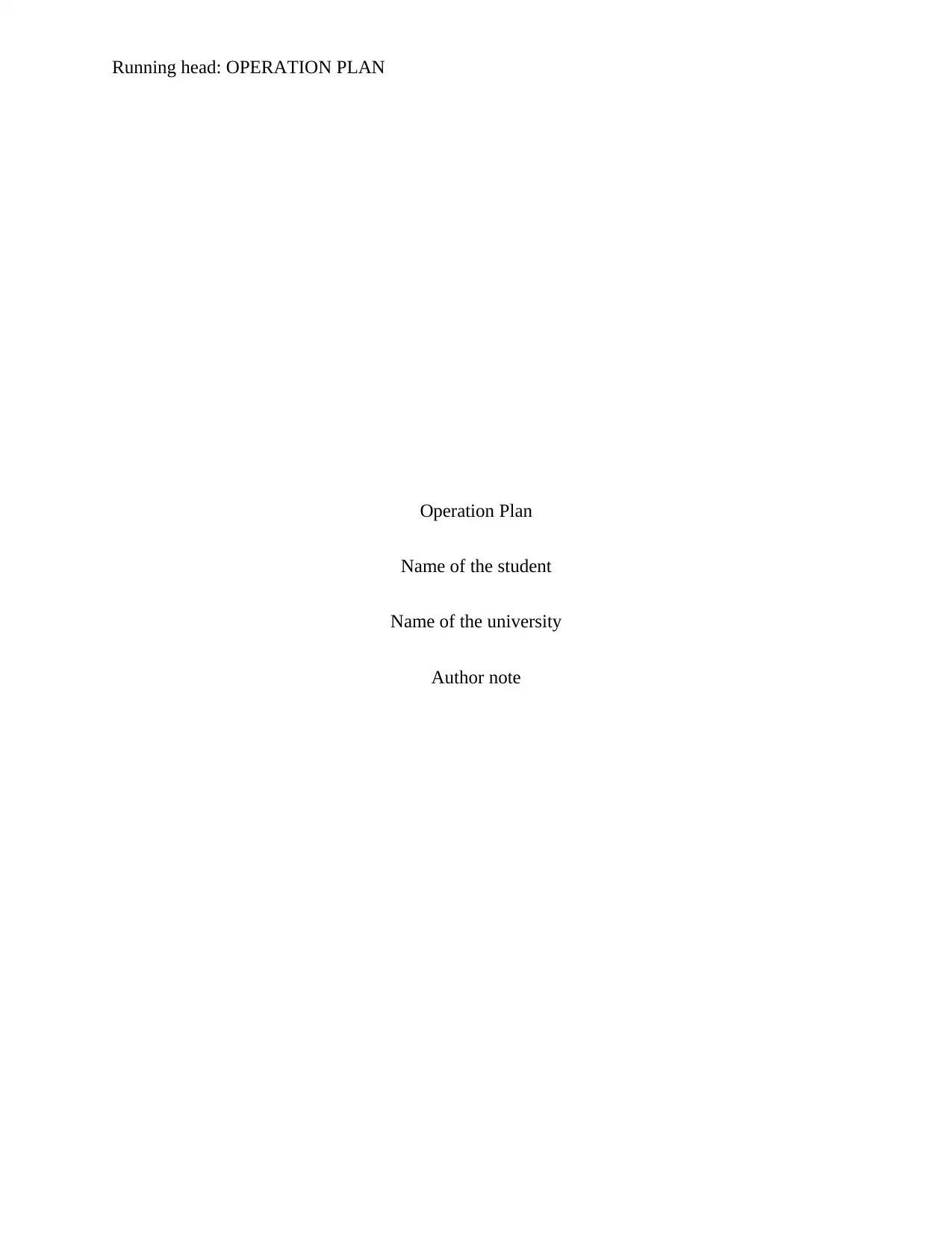
Running head: OPERATION PLAN
Operation Plan
Name of the student
Name of the university
Author note
Operation Plan
Name of the student
Name of the university
Author note
Paraphrase This Document
Need a fresh take? Get an instant paraphrase of this document with our AI Paraphraser
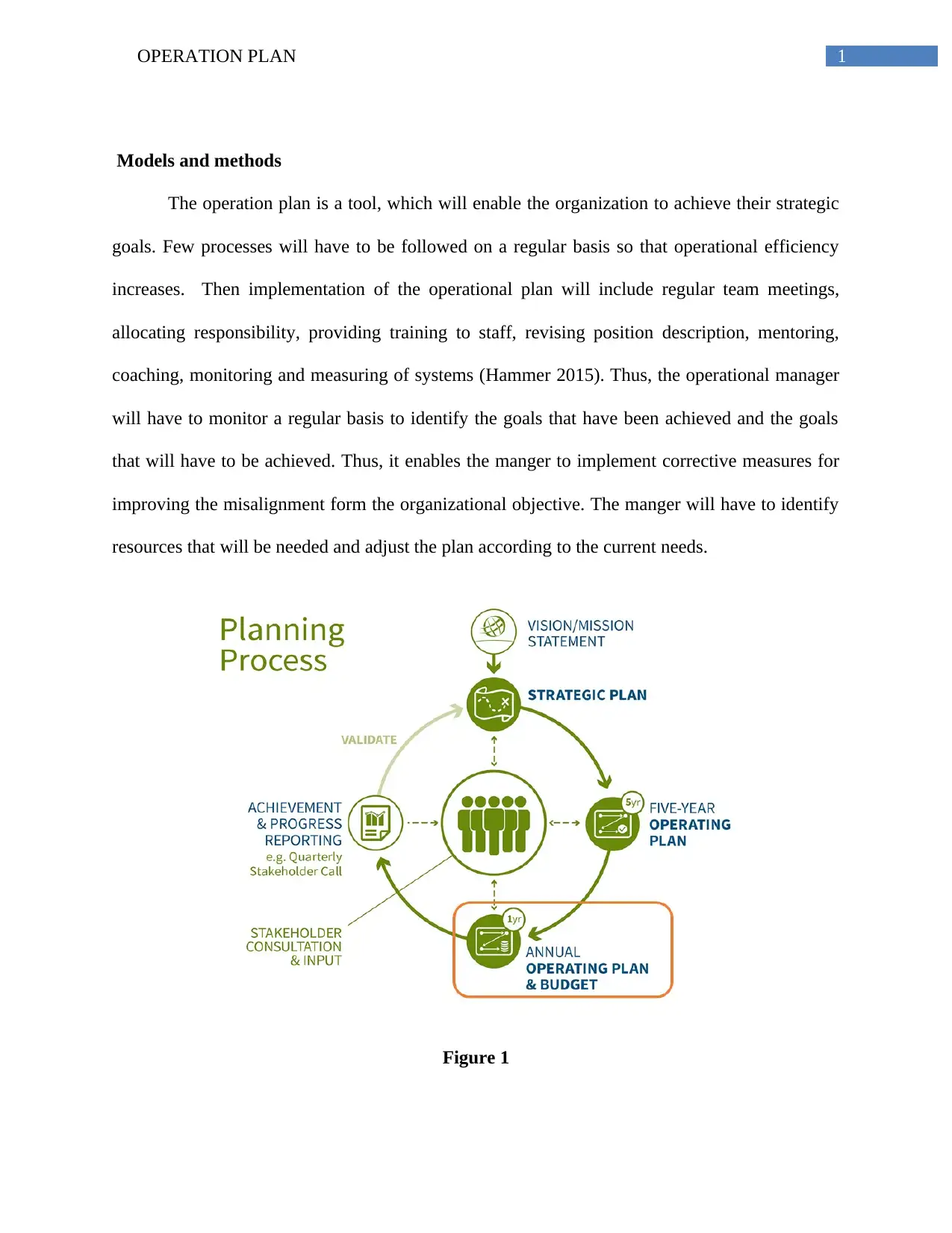
1OPERATION PLAN
Models and methods
The operation plan is a tool, which will enable the organization to achieve their strategic
goals. Few processes will have to be followed on a regular basis so that operational efficiency
increases. Then implementation of the operational plan will include regular team meetings,
allocating responsibility, providing training to staff, revising position description, mentoring,
coaching, monitoring and measuring of systems (Hammer 2015). Thus, the operational manager
will have to monitor a regular basis to identify the goals that have been achieved and the goals
that will have to be achieved. Thus, it enables the manger to implement corrective measures for
improving the misalignment form the organizational objective. The manger will have to identify
resources that will be needed and adjust the plan according to the current needs.
Figure 1
Models and methods
The operation plan is a tool, which will enable the organization to achieve their strategic
goals. Few processes will have to be followed on a regular basis so that operational efficiency
increases. Then implementation of the operational plan will include regular team meetings,
allocating responsibility, providing training to staff, revising position description, mentoring,
coaching, monitoring and measuring of systems (Hammer 2015). Thus, the operational manager
will have to monitor a regular basis to identify the goals that have been achieved and the goals
that will have to be achieved. Thus, it enables the manger to implement corrective measures for
improving the misalignment form the organizational objective. The manger will have to identify
resources that will be needed and adjust the plan according to the current needs.
Figure 1
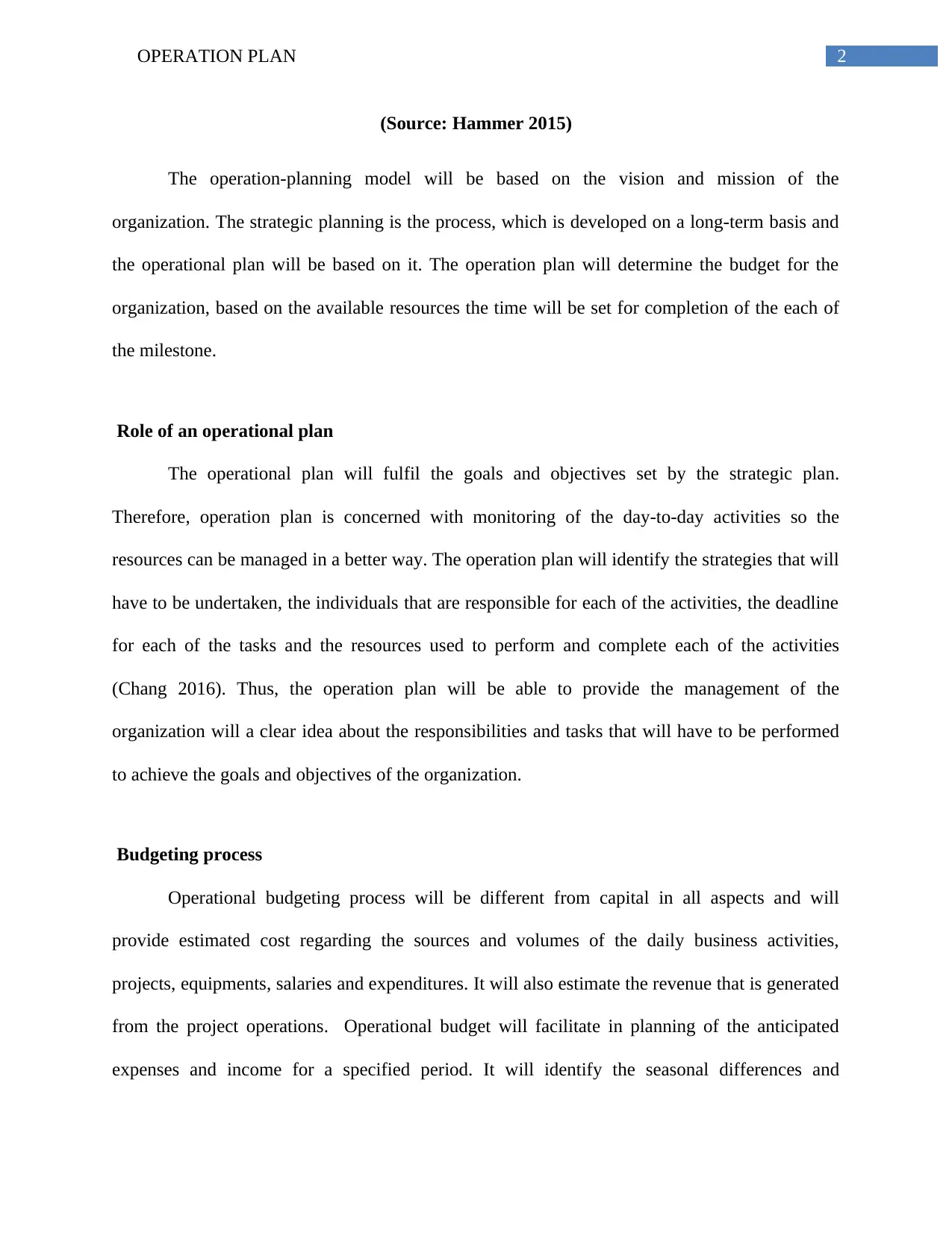
2OPERATION PLAN
(Source: Hammer 2015)
The operation-planning model will be based on the vision and mission of the
organization. The strategic planning is the process, which is developed on a long-term basis and
the operational plan will be based on it. The operation plan will determine the budget for the
organization, based on the available resources the time will be set for completion of the each of
the milestone.
Role of an operational plan
The operational plan will fulfil the goals and objectives set by the strategic plan.
Therefore, operation plan is concerned with monitoring of the day-to-day activities so the
resources can be managed in a better way. The operation plan will identify the strategies that will
have to be undertaken, the individuals that are responsible for each of the activities, the deadline
for each of the tasks and the resources used to perform and complete each of the activities
(Chang 2016). Thus, the operation plan will be able to provide the management of the
organization will a clear idea about the responsibilities and tasks that will have to be performed
to achieve the goals and objectives of the organization.
Budgeting process
Operational budgeting process will be different from capital in all aspects and will
provide estimated cost regarding the sources and volumes of the daily business activities,
projects, equipments, salaries and expenditures. It will also estimate the revenue that is generated
from the project operations. Operational budget will facilitate in planning of the anticipated
expenses and income for a specified period. It will identify the seasonal differences and
(Source: Hammer 2015)
The operation-planning model will be based on the vision and mission of the
organization. The strategic planning is the process, which is developed on a long-term basis and
the operational plan will be based on it. The operation plan will determine the budget for the
organization, based on the available resources the time will be set for completion of the each of
the milestone.
Role of an operational plan
The operational plan will fulfil the goals and objectives set by the strategic plan.
Therefore, operation plan is concerned with monitoring of the day-to-day activities so the
resources can be managed in a better way. The operation plan will identify the strategies that will
have to be undertaken, the individuals that are responsible for each of the activities, the deadline
for each of the tasks and the resources used to perform and complete each of the activities
(Chang 2016). Thus, the operation plan will be able to provide the management of the
organization will a clear idea about the responsibilities and tasks that will have to be performed
to achieve the goals and objectives of the organization.
Budgeting process
Operational budgeting process will be different from capital in all aspects and will
provide estimated cost regarding the sources and volumes of the daily business activities,
projects, equipments, salaries and expenditures. It will also estimate the revenue that is generated
from the project operations. Operational budget will facilitate in planning of the anticipated
expenses and income for a specified period. It will identify the seasonal differences and
⊘ This is a preview!⊘
Do you want full access?
Subscribe today to unlock all pages.

Trusted by 1+ million students worldwide
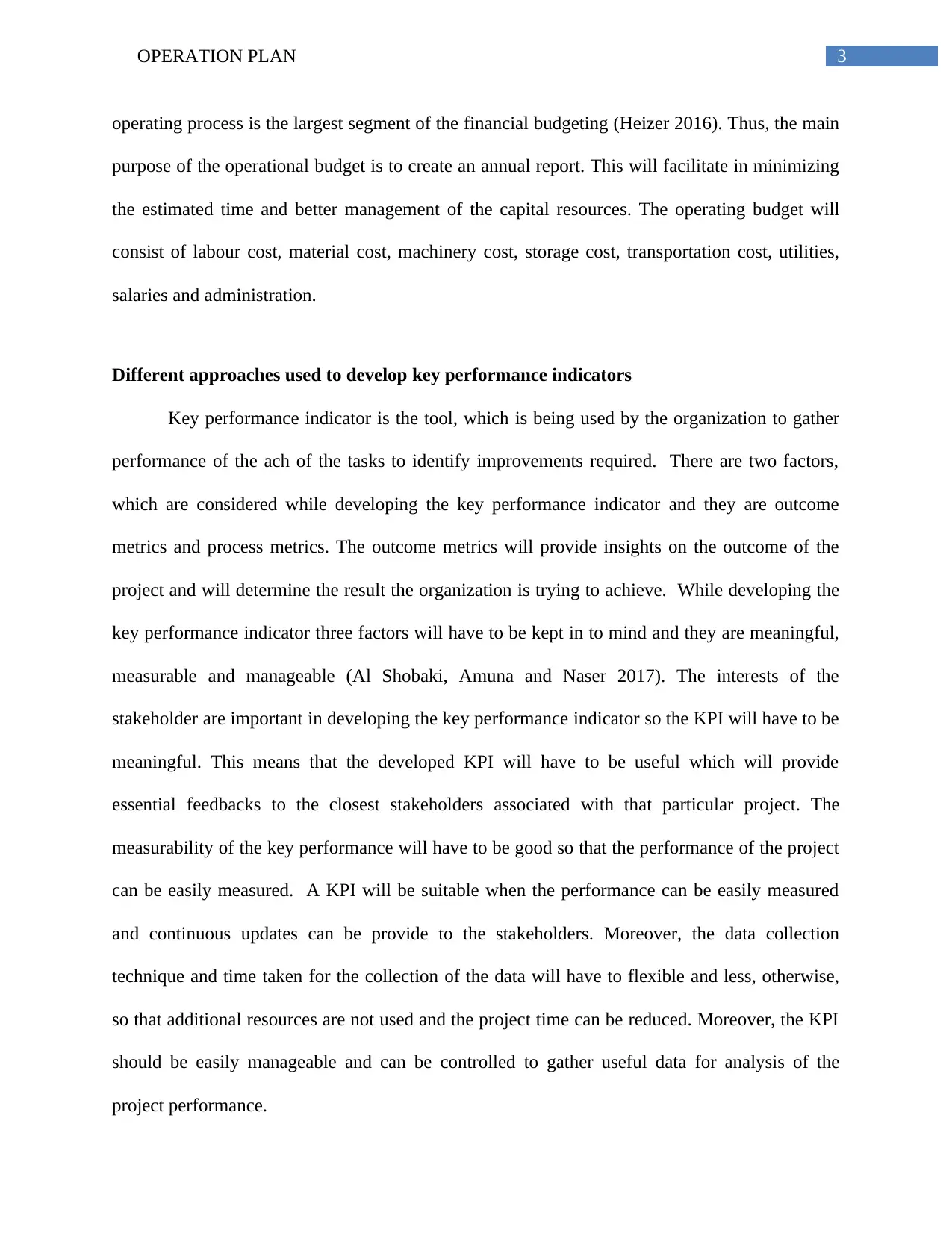
3OPERATION PLAN
operating process is the largest segment of the financial budgeting (Heizer 2016). Thus, the main
purpose of the operational budget is to create an annual report. This will facilitate in minimizing
the estimated time and better management of the capital resources. The operating budget will
consist of labour cost, material cost, machinery cost, storage cost, transportation cost, utilities,
salaries and administration.
Different approaches used to develop key performance indicators
Key performance indicator is the tool, which is being used by the organization to gather
performance of the ach of the tasks to identify improvements required. There are two factors,
which are considered while developing the key performance indicator and they are outcome
metrics and process metrics. The outcome metrics will provide insights on the outcome of the
project and will determine the result the organization is trying to achieve. While developing the
key performance indicator three factors will have to be kept in to mind and they are meaningful,
measurable and manageable (Al Shobaki, Amuna and Naser 2017). The interests of the
stakeholder are important in developing the key performance indicator so the KPI will have to be
meaningful. This means that the developed KPI will have to be useful which will provide
essential feedbacks to the closest stakeholders associated with that particular project. The
measurability of the key performance will have to be good so that the performance of the project
can be easily measured. A KPI will be suitable when the performance can be easily measured
and continuous updates can be provide to the stakeholders. Moreover, the data collection
technique and time taken for the collection of the data will have to flexible and less, otherwise,
so that additional resources are not used and the project time can be reduced. Moreover, the KPI
should be easily manageable and can be controlled to gather useful data for analysis of the
project performance.
operating process is the largest segment of the financial budgeting (Heizer 2016). Thus, the main
purpose of the operational budget is to create an annual report. This will facilitate in minimizing
the estimated time and better management of the capital resources. The operating budget will
consist of labour cost, material cost, machinery cost, storage cost, transportation cost, utilities,
salaries and administration.
Different approaches used to develop key performance indicators
Key performance indicator is the tool, which is being used by the organization to gather
performance of the ach of the tasks to identify improvements required. There are two factors,
which are considered while developing the key performance indicator and they are outcome
metrics and process metrics. The outcome metrics will provide insights on the outcome of the
project and will determine the result the organization is trying to achieve. While developing the
key performance indicator three factors will have to be kept in to mind and they are meaningful,
measurable and manageable (Al Shobaki, Amuna and Naser 2017). The interests of the
stakeholder are important in developing the key performance indicator so the KPI will have to be
meaningful. This means that the developed KPI will have to be useful which will provide
essential feedbacks to the closest stakeholders associated with that particular project. The
measurability of the key performance will have to be good so that the performance of the project
can be easily measured. A KPI will be suitable when the performance can be easily measured
and continuous updates can be provide to the stakeholders. Moreover, the data collection
technique and time taken for the collection of the data will have to flexible and less, otherwise,
so that additional resources are not used and the project time can be reduced. Moreover, the KPI
should be easily manageable and can be controlled to gather useful data for analysis of the
project performance.
Paraphrase This Document
Need a fresh take? Get an instant paraphrase of this document with our AI Paraphraser
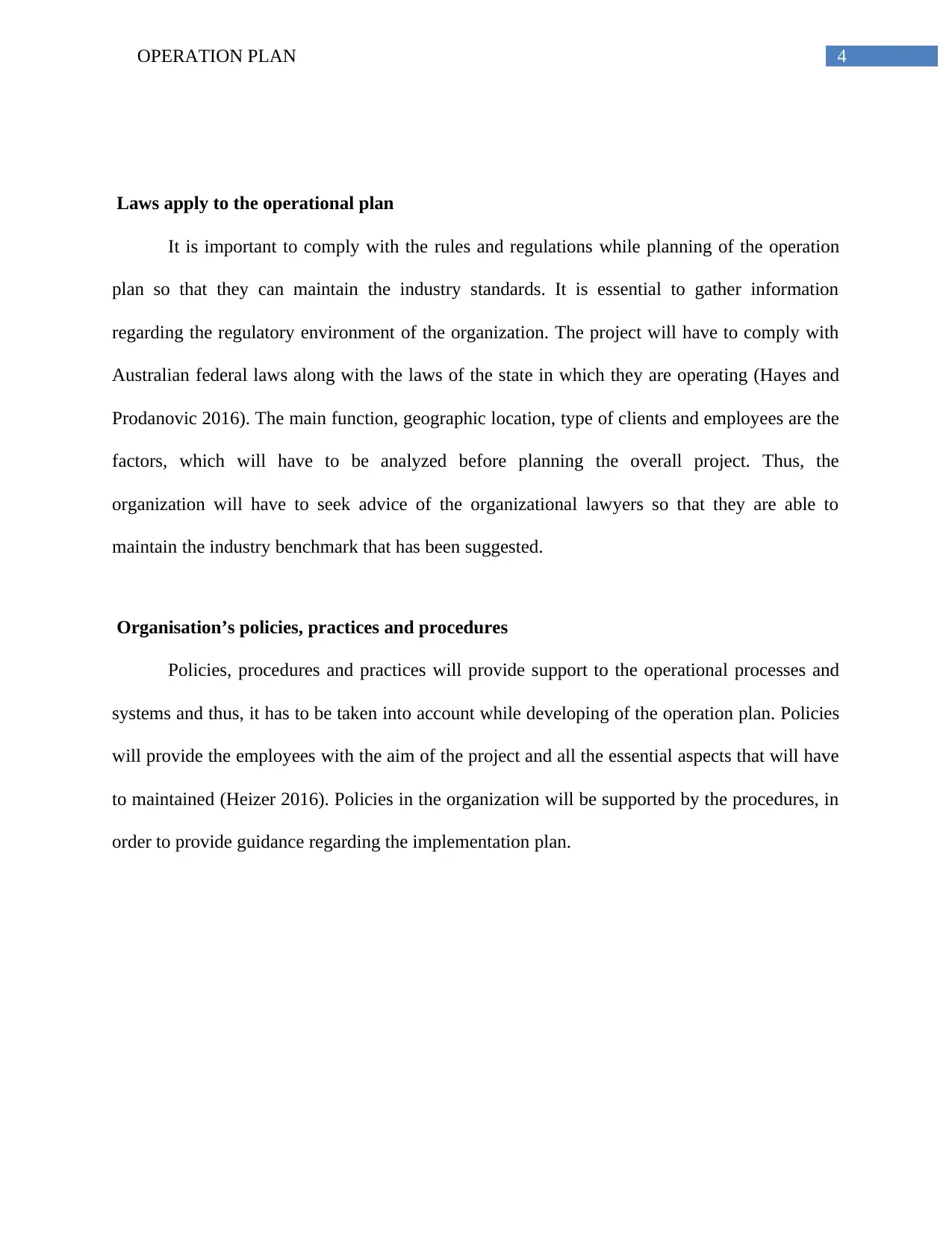
4OPERATION PLAN
Laws apply to the operational plan
It is important to comply with the rules and regulations while planning of the operation
plan so that they can maintain the industry standards. It is essential to gather information
regarding the regulatory environment of the organization. The project will have to comply with
Australian federal laws along with the laws of the state in which they are operating (Hayes and
Prodanovic 2016). The main function, geographic location, type of clients and employees are the
factors, which will have to be analyzed before planning the overall project. Thus, the
organization will have to seek advice of the organizational lawyers so that they are able to
maintain the industry benchmark that has been suggested.
Organisation’s policies, practices and procedures
Policies, procedures and practices will provide support to the operational processes and
systems and thus, it has to be taken into account while developing of the operation plan. Policies
will provide the employees with the aim of the project and all the essential aspects that will have
to maintained (Heizer 2016). Policies in the organization will be supported by the procedures, in
order to provide guidance regarding the implementation plan.
Laws apply to the operational plan
It is important to comply with the rules and regulations while planning of the operation
plan so that they can maintain the industry standards. It is essential to gather information
regarding the regulatory environment of the organization. The project will have to comply with
Australian federal laws along with the laws of the state in which they are operating (Hayes and
Prodanovic 2016). The main function, geographic location, type of clients and employees are the
factors, which will have to be analyzed before planning the overall project. Thus, the
organization will have to seek advice of the organizational lawyers so that they are able to
maintain the industry benchmark that has been suggested.
Organisation’s policies, practices and procedures
Policies, procedures and practices will provide support to the operational processes and
systems and thus, it has to be taken into account while developing of the operation plan. Policies
will provide the employees with the aim of the project and all the essential aspects that will have
to maintained (Heizer 2016). Policies in the organization will be supported by the procedures, in
order to provide guidance regarding the implementation plan.
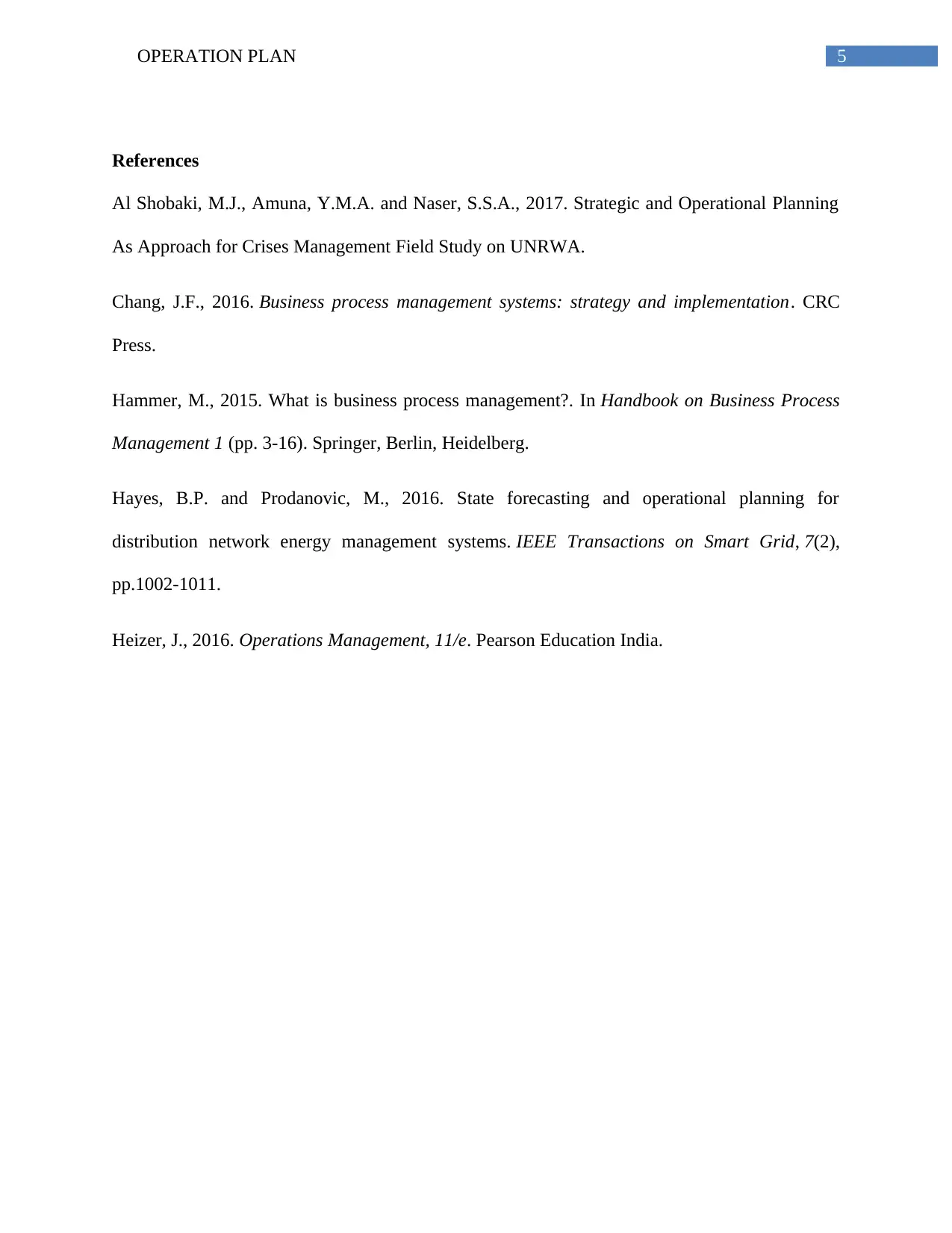
5OPERATION PLAN
References
Al Shobaki, M.J., Amuna, Y.M.A. and Naser, S.S.A., 2017. Strategic and Operational Planning
As Approach for Crises Management Field Study on UNRWA.
Chang, J.F., 2016. Business process management systems: strategy and implementation. CRC
Press.
Hammer, M., 2015. What is business process management?. In Handbook on Business Process
Management 1 (pp. 3-16). Springer, Berlin, Heidelberg.
Hayes, B.P. and Prodanovic, M., 2016. State forecasting and operational planning for
distribution network energy management systems. IEEE Transactions on Smart Grid, 7(2),
pp.1002-1011.
Heizer, J., 2016. Operations Management, 11/e. Pearson Education India.
References
Al Shobaki, M.J., Amuna, Y.M.A. and Naser, S.S.A., 2017. Strategic and Operational Planning
As Approach for Crises Management Field Study on UNRWA.
Chang, J.F., 2016. Business process management systems: strategy and implementation. CRC
Press.
Hammer, M., 2015. What is business process management?. In Handbook on Business Process
Management 1 (pp. 3-16). Springer, Berlin, Heidelberg.
Hayes, B.P. and Prodanovic, M., 2016. State forecasting and operational planning for
distribution network energy management systems. IEEE Transactions on Smart Grid, 7(2),
pp.1002-1011.
Heizer, J., 2016. Operations Management, 11/e. Pearson Education India.
⊘ This is a preview!⊘
Do you want full access?
Subscribe today to unlock all pages.

Trusted by 1+ million students worldwide
1 out of 6
Related Documents
Your All-in-One AI-Powered Toolkit for Academic Success.
+13062052269
info@desklib.com
Available 24*7 on WhatsApp / Email
![[object Object]](/_next/static/media/star-bottom.7253800d.svg)
Unlock your academic potential
Copyright © 2020–2025 A2Z Services. All Rights Reserved. Developed and managed by ZUCOL.





